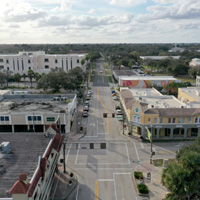 Hike in housing density seen needed to revitalize downtown
Hike in housing density seen needed to revitalize downtown
STORY BY RAY MCNULTY (Week of May 23, 2024)
The Vero Beach City Council took another step toward adopting a downtown master plan last week, when it approved more than tripling the housing density limit in the downtown district to accommodate the type of rental apartments needed to attract young people.
“The downtown is for young people who want a nightlife,” said urban planning guru Andres Duany, adding, “You raise the density and you will get many small apartments, instead of a few big ones. … You want a lot of small apartments and studios, which are what young people want.
“The young people pioneer downtowns,” he continued. “Therefore, you have to raise the density.”
Council members were so impressed with the vision for Vero’s downtown developed by Duany and his Miami-based DPZ CoDesign team, in fact, that they’re preparing to ask city voters to approve in a November referendum a charter amendment to the current unit-per-acre density limit from 17 to as much as 60.
Council members and Jeffries shared Duany’s concern that some residents might wrongly believe that increasing density to 60 units per acre in the downtown district would lead to the construction of high-rise apartment buildings.
Such construction, however, would require a separate referendum to amend the charter’s current 50-foot height restriction.
“People tend to conflate density with height, but we’re not going to violate the height limit,” Mayor John Cotugno said last week. “That’s not going happen. We need to explain what we’re doing and why, and show people what our downtown could be.”
City Planning Director Jason Jeffries projected that the downtown district, which he said covers about 50 acres, could accommodate approximately 2,500 residential units, based on the existing land-use designations in the city’s comprehensive plan, the number of sites likely to be developed and four-story buildings.
But some residential buildings might be only three stories high, he said, which could reduce the actual density to as low as 40 units per acre.
“We still have more calculations to do,” Jeffries said, adding that Naples adopted the same planning and development strategy when DPZ CoDesign created the Southwest Florida city’s plan to revitalize its downtown area in the early 1990s.
Duany explained to council members he understood the potential difficulties that accompany local governments seeking density increases, especially in smaller communities, where residents are often concerned that it sets a precedent for similar changes in other parts of the city.
More than tripling the maximum density currently allowed in the downtown district “sounds incredibly frightening,” Duany said, so it’s vital that city officials assure residents that the increase won’t change the feel of the community.
“It’s still within the vision of Vero,” he said of the proposed density increase, later adding, “It just begins to look like a really good American downtown.”
And it would only be in the Vero downtown.
The council instructed Jeffries to bring to Tuesday’s 6 p.m. meeting suggested language for a charter amendment. To include a downtown-density referendum on the November ballot, the city must provide the wording to the county’s Supervisor of Elections Office no later than mid-August.
City officials also have some educating to do, if they hope to see the proposed referendum approved by voters. Jeffries and City Attorney John Turner must find a way to clearly-but-concisely describe the referendum’s intent and limits in the 75 words Florida law allows.
“How do you explain three-dimensional concepts in one-dimensional language, and do it in only 75 words?” Cotugno said. “How do you describe what 60 units per acre looks like? That’s going to be a challenge.”
Other challenges include convincing skeptical voters that:
• The city’s already-improved downtown needs a significant revitalization and that increasing density is the way to accomplish it, especially at a time when property owners in the district are leasing for the highest rents ever.
• The proposed increase in density will prompt construction of the smaller, more-affordable apartments that attract younger adults to downtowns in other cities, even though the Vero Beach area lacks the well-paying jobs sought by the desired demographic.
• The city can successfully and simultaneously support the development of a waterfront dining, retail, social and recreational hub at the Three Corners site and a re-energized and expanded downtown.
“You’re always concerned when you go to referendum,” Cotugno said, “but if you present it correctly and answer the public’s questions to give assurance that this will benefit the community …
“That’s all you can do.”
State law prohibits local governments from publicly endorsing or promoting a position on referendums.
The council, which began discussing the possibility of creating a downtown master plan last year, in December hired Duany and DPZ CoDesign, who previously created the city’s Three Corners Master Concept Plan, to develop one.
Duany began work in February, when he spent a week visiting downtown establishments and talking with local business owners and other stakeholders.
That visit provided the foundation for Duany’s vision for the downtown district’s future.
Although DPZ CoDesign’s extensive and detailed report covers areas adjacent to and beyond the district – from as far north as Vero Beach Regional Airport to south of Vero Beach High School, and from the Florida East Coast Railway tracks west to 20th Avenue – the plan’s initial focus is on a four-block stretch of 14th Avenue.
“We’ve identified where to start in a concentrated way,” Duany said, adding that the downtown core should eventually expand. “But you can’t just do a little bit here and a little bit there, and nothing adds up.”
He said he believes the city’s downtown district has tremendous potential, and he encouraged the owners of properties and local businesses along the 14th Street corridor and its tentacles to take immediate steps to improve their appearances with new facades and awnings.
He also suggested the council consider moving City Hall to the former courthouse across from Pocahontas Park.
“A lot is happening already,” Duany said. “There’s more than enough to do at night here. There’s more than enough to eat. It doesn’t look it, particularly during the day, but there’s life coming on … So you have the wind in your sails.”
Cotugno agreed, though he acknowledged the there are significant differences between the Three Corners project, where the city will partner with one developer, and downtown revitalization effort, which would involve multiple landlords, business owners and builders.
“Both the Three Corners and downtown plans are aspirational,” the mayor said. “But five or six years from now, the Three Corners will be done. Downtown, it’s going to take time, probably longer than the Three Corners.
“The downtown project is never going to be finished, really, because if all goes as we hope it does, it will be ongoing,” he continued. “So you start with the downtown core and you keep expanding as people get caught up in the excitement and want to be part of it. And you get a ripple effect.”
He paused for a moment, then added, “The question we can’t answer now is: Will this effort pass from council to council?”



